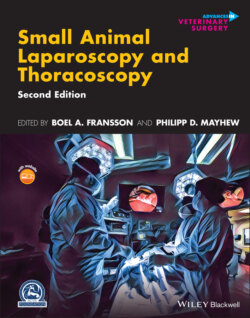Читать книгу Small Animal Laparoscopy and Thoracoscopy - Группа авторов - Страница 77
Light Cables
ОглавлениеA fiber optic cable transmits the light from the source to the telescope. It consists of a bundle of thousands of optical glass fibers ranging in size from 30 to several hundred microns, surrounded by a protective jacket, and equipped with metal fittings at each end. Cables with additional armoring last longer than ones without this protection. The cable is inserted into the light source at one end and attached to the light post of the telescope at the other end. Light cables are available in various styles and diameters, depending on the diameter of the telescope. Correct matching prevents overheating or under illumination. Generally, a smaller scope requires a smaller light cable. The most common cable used with 5‐mm telescopes for small animal MIS is 3.5 mm in diameter and 300 cm long (Table 3.2) [1–5]. The extended length 300 cm light cables provide better ergonomics since in most laparoscopic and thoracoscopic procedures a minimum of 1.5 m distance exists between the operating table and the surgical field. A free range of motion increases the surgeon's ability and ergonomics resulting in faster and safer procedures and also avoids excess drag to the imaging equipment setup.
Table 3.2 Matching diameter of telescope and light cable for optimal illumination and to avoid overheating.
| Telescope diameter (mm) | Recommended cable diameter (mm) |
|---|---|
| 6.5–12 | 4.8–5.0 |
| 3.0–6.5 | 3.0–3.5 |
| 0.8–2.9 | 2.0–2.5 |
Careful handling of a light cable will prolong its life span, avoiding discoloration of the ends and breakage of individual fibers. Light cable integrity is assessed by looking through one end of the cable toward a room light or window. However, over time discoloration reduces light transmission and can change the color of the light that is emitted. Broken fibers will appear as small black or gray areas. When more than 30% of the fibers are broken, replacement of the cable is recommended. Excessive bending, twisting, or crushing of light cables should be avoided to minimize fiber breakage.
Contemporary light cables are autoclavable, but manufacturers' recommendations for time and cycle should be carefully followed using an appropriate sterilizer. Light cables should always be stored alone in adequate containers in a loosely coiled position, to minimize stress on the glass fibers.
When considering fluorescence technologies, a specific light cable is mandatory due to intrinsic wavelengths' transmission ability. Depending on the configuration of the video system, one should consider “fluorescence fluid” or “fluorescence fiberoptic” light cables. Since the most common fluorescence applications in veterinary surgery use ICG, the more frequently chosen type of cable corresponds to the fiber optic version.
